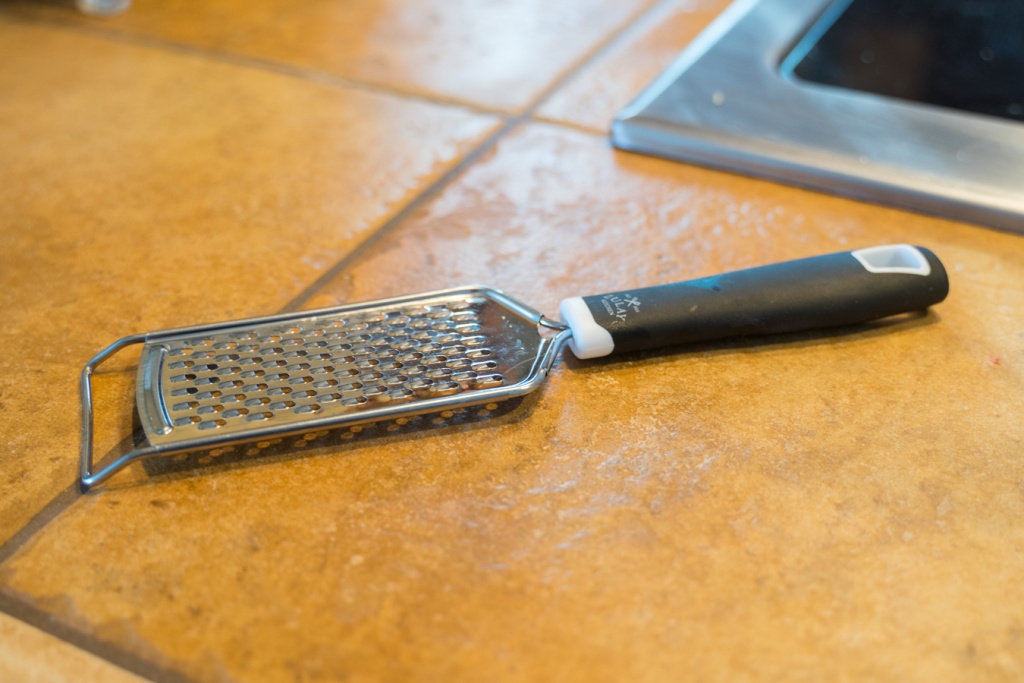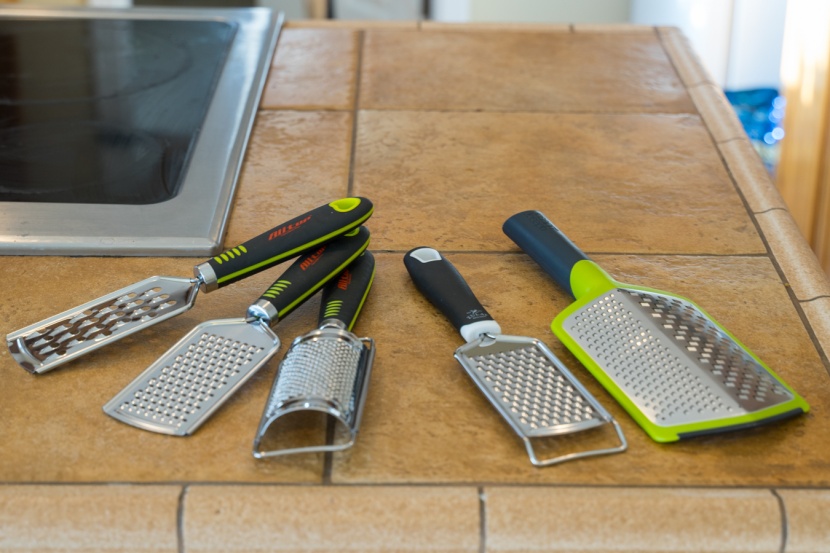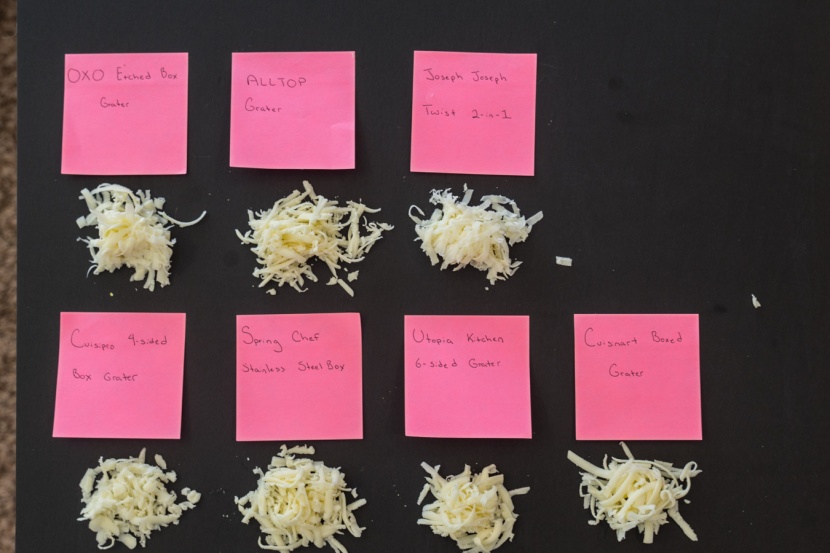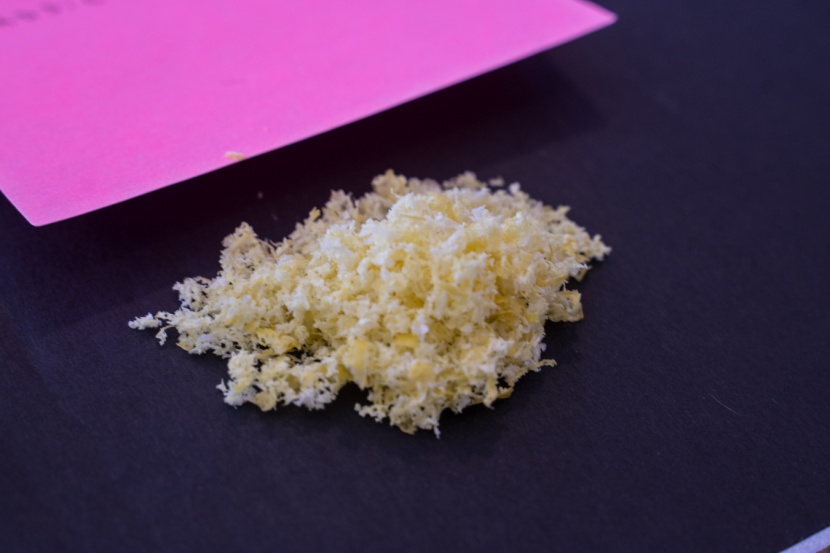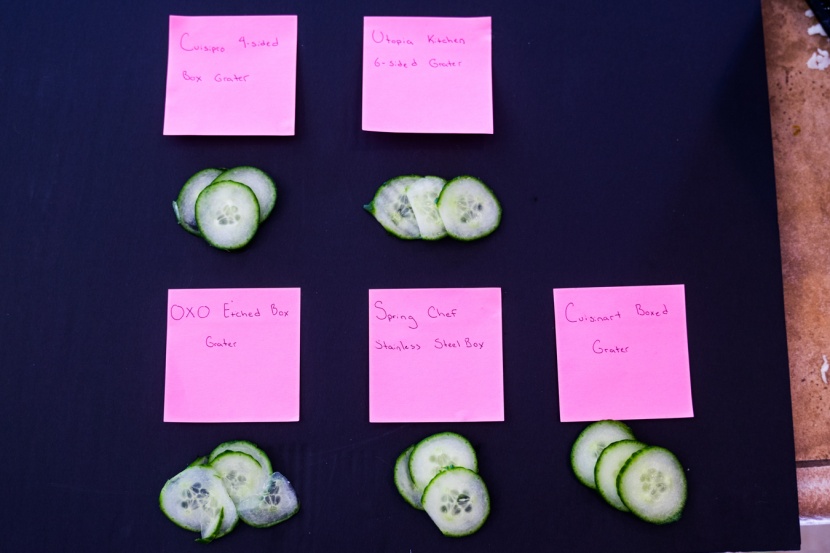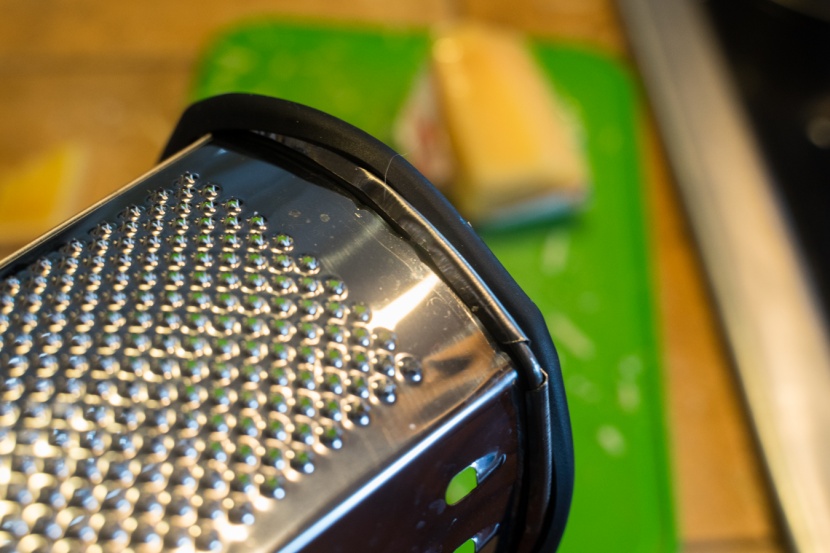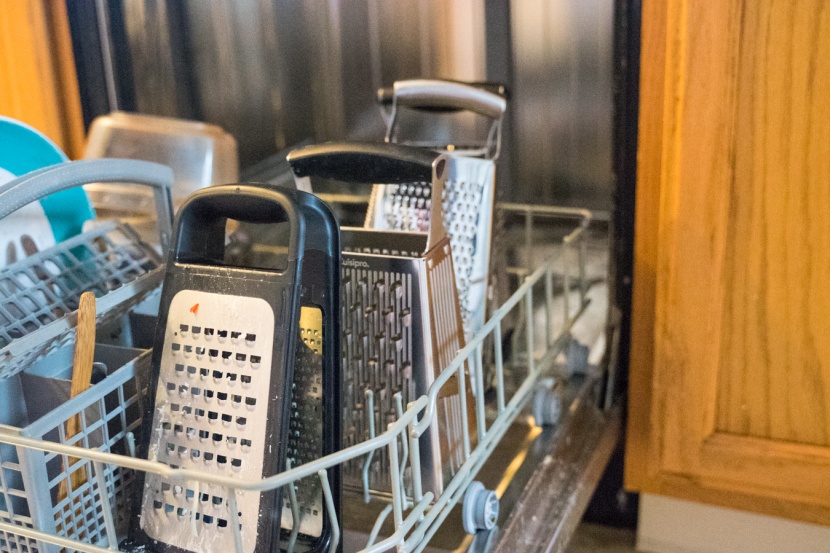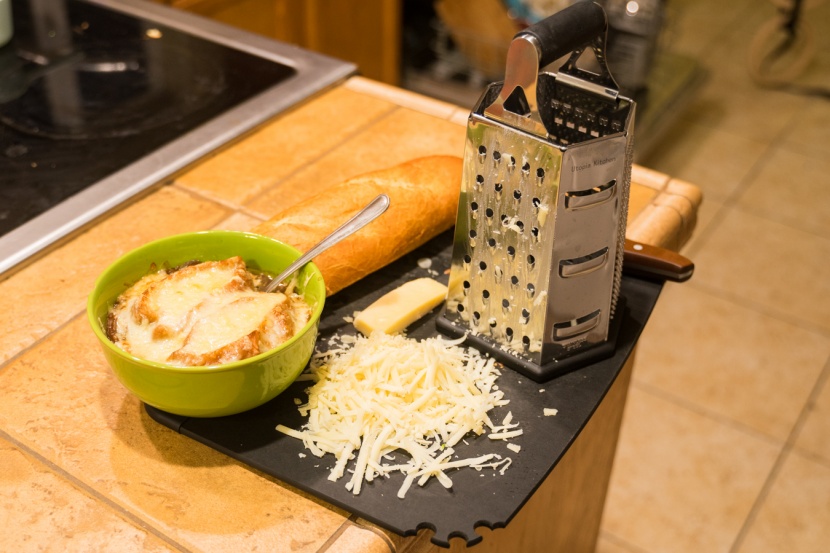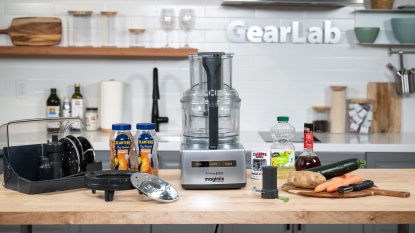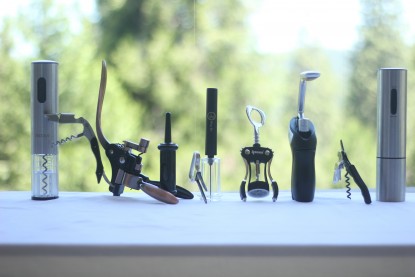We researched over 30 various models and designs before purchasing and hands-on testing the best 10 graters available today. Our culinary experts created a gauntlet of tests to run each model through to find the sharpest and most versatile models. A good grater can shred through beets and carrots to add excitement and variety to your salads, zest citrus rinds for dressings and marinades, and of course, grate cheeses into delicious piles for potato and pasta dishes. We've evaluated each model's grating surfaces, sharpness, and special features so you can easily select the perfect tool for your kitchen.
If you're searching for helpful kitchen gadgets that make cooking easier, our cooking tools reviews will be of interest to you. Our kitchen pros have tested garlic presses, top-ranked can openers, pasta makers, spice grinders, and even the best salad spinners to wash and dry your leafy greens.
Our Top Picks
10 Best Graters
The Cuisipro 4-Sided Box Grater may look similar to other models you've seen, but in terms of performance, it's in a league of its own. This tool rules the kitchen — not with gimmicky features, not with a smorgasbord of grating surfaces, but with pure dominance of the sharpness arena. In our testing, we find that sharpness is the most important characteristic of a great grater. The Cuisipro's tiny razor teeth churned out heaps of thin citrus zests, while the larger holes sliced through the softest mozzarellas, producing thin, uniform shreds. The sharp teeth made for smooth grating action, and our testers didn't experience any jerky, knuckle-scraping movements while processing cheese and vegetables with this model. The Cuisipro's four sides include the standard grating surfaces; fine, coarse, extra coarse, and a slicer.
The razor-sharp etched teeth and grooved surfaces come at a steep price, making the Cuisipro one of the more expensive models in our review. As with all graters, there's no way to sharpen the teeth once they become dull. If you want the best for fluffy parmesan as well as turning your beets into a deep purple pile of shredded nutrition, the Cuisipro is the one we highly recommend.
The Utopia Kitchen 6-Sided Grater is a versatile option offering many different grating surfaces. It makes short work of medium-hard cheeses like gruyere and white cheddars, but what really impresses us is the slicer surface. The slicer side features three ridged slicer blades, producing three slices with one stroke. They turned our pickles into rigid, uniform chips, which not all graters could do. The rubber handle and base are especially useful when grating large amounts of cheese, keeping the base stable no matter how slippery your cutting board might get during an epic disaster-style cooking project. To top things off, this is one of the most affordable models on the market.
This isn't the sharpest grater we tested, and its mozzarella shavings were chunkier and less uniform than those produced by some of the premium graters. The zester surface also cut straight through orange rinds instead of leaving the white pith behind. Since blade sharpening is not an option, this model will only get duller. The rubber handle and base provide stability so you can put a little more muscle into grating harder cheeses. But over time, the soft cheese may become difficult to process successfully, and after a few weeks and lots of testing trials, we began to notice the rubber base slipping off. However, for the money, the Utopia Kitchen offers the most grating surfaces, making it a great choice for versatility on a budget.
"No matter what kind of grater you have, you also need to have a Microplane in your kitchen," one of our testers exclaimed during zesting testing. The Microplane Premium Classic Zester is the Kleenex of zesters, for a good reason. The hot-knife-through-cold-butter saying is very much applicable here when grating parmesan. It's almost effortless to carve a perfect microplane-shaped chunk out of a block of parm, rendering a fluffy pile of cheese, ready to infuse every nook and cranny of your salad or pasta with flavor. For zesting, the Microplane's razor-sharp teeth shaves off just the right amount of peel without carving too deep into the pith (the bitter part of the citrus), like some duller models we tested.
This one (or two) trick pony is what it is. Besides zesting, hard cheeses, and ginger, there's not much else it can do, hence the need for a more versatile model to complement the Microplane. No other in our test group had a zesting surface that can compare to this one, making the Microplane a necessity for serious chefs.
Known for high-quality kitchenware and cool ideas, OXO's take on this kitchen tool category falls in line with what we've come to expect from the brand. The OXO Etched Box Grater model adds useful innovation to this category. The zester (which zests very well, only second to the Microplane) is removable, so you can easily grate directly onto your food as you would with a rasp-style product. Also included is a graduated container that fits onto the base to collect and measure shavings.
Despite the cool features of the OXO, it's not the sharpest grater in the bunch. The competition is stiff, and compared to the Cuisipro, the OXO just isn't as sharp. We think the detachable zester and container are quite useful, but some folks may be wary of detachable (aka easily misplaced) parts. For everyone else, this is an excellent choice for user-friendliness and versatility.
The Joseph Joseph Twist Grater is a compact little tool that can do a lot for its small size. On the surface, it's a rasp-style grater with one angled face that includes two grating surfaces; fine and coarse. However, the handle can twist 90° and becomes a support leg, making it much easier to grade large amounts of cheese or veggies. This model comes close to the stability of the box-style models without taking up as much space in your kitchen cabinet or drawer.
Compared to box-style graters, this rasp-style one can't shred through loads of cheese as quickly, but the twisting handle does make it more ergonomic than most other rasp models. In testing, we discovered that while this model can zest and coarsely shred, it's not the best at either task. The Twist's size is fairly limiting, too, for root vegetables and large chunks of cheese. However, if you don't want to take up the space of a box model, the Joseph Joseph Twist can do more than most rasps, and you may be able to get away with owning just this one tool instead of multiple.
Rasp-style models look the best on your dinner table, and they need to look elegant while being convenient for folks who just need more fresh parmesan on their pasta. The ALLTOP Grater is a high-value 3-pack that has all your tableside grating needs covered. Included is a fine grating surface for zesting or parmesan, a fine shredder, and a coarse shredder. Each is solidly constructed and held up well during our test trials. Another bonus to their small size is that they'll fit better in crowded drawers, making them great for a small home or RV with limited storage.
For serious cooks who frequently grate large quantities of veggies or soft cheeses, this grater isn't up to snuff. Try quickly grinding a big potato, and you will find yourself exhausted due to the small coarse blades. However, if you only plan on grating tableside cheese or the occasional zesting, the ALLTOP set is a decent choice at an affordable price.
The Cuisinart Boxed Grater model we tested is a popular box-style utensil that checks all the boxes, despite a few flaws. It has coarse and fine shredding surfaces, as well as a fine grating surface and a three-bladed slicer. The rubber foot helps with stability and adds some confidence when shredding root vegetables. The three-bladed slicer is especially useful, and we think it should be standard on box-style models.
After a few runs through the dishwasher, we noticed some rust forming where the rubber foot covers the base, which is not what we expected from stainless steel. This is the only model where we encountered this problem. So, if there are updates that fix this issue, this model would be a solid choice. Currently, it's not what we'd recommend to a friend.
The stainless steel Spring Chef Stainless Steel Box is ready to take a beating. This sturdy model is sharp enough to handle hundreds of beets and demolish potatoes for the hash browns of your dreams. It also has a capable zesting surface and a sharp, albeit singular, veggie slicer.
This model is a bit lacking in the ergonomic department. Its all-steel handle gets slippery when wet from potato or onion grating. The rubber foot helps maintain stability, but we find that it rolls off very easily and is barely attached to the box body. However, if you tend to be hard on your kitchen gadgets and want one for the long haul, this might be the model for you.
The Deiss Pro Citrus Zester is a decent alternative to the beloved Microplane, and its strengths are where it most differs from its main competition. This zester is about an inch and a half wide and has a rubber foot on the end, so you can brace it against the counter while you zest or grate. This makes it better for high-volume objectives (think: tons of ginger or piles of parmesan).
This zester is not as sharp as the Microplane Zester, a fact that was obvious to our testers right away. The Microplane produces a finer zest and takes longer to cut into the pith of the citrus (a good thing), while the Deiss Pro tends to cut deeper and not as smoothly. So if high volume is a must, the Diess Pro may be a better choice, but for fine and consistent zests, we recommend the Microplane.
If you're not picky, the Zulay Professional Grater could be all you need to keep the cheese fiends in your home happy. This little rasp-style model is sharp and has a bar on the end you can use to brace against a cutting board if you need to use it for more than just a sprinkling of cheese. The handle has a little hole in the top for easy storage, and the whole package certainly looks “professional.”
Our testers find the rasp-style models fairly limiting. You only get one style of grating surface. The utensil itself isn't very large, so you'll be grating a long time to get through a block of mozzarella or a potato. But if you only need a grating utensil for the table, the Zulay could work fine.
Why Trust GearLab
After diligent research, we identified the top models on the market and purchased the most promising ones. In the following weeks, we grated up a storm, rendering potatoes into shredded piles of delicious hash browns, onions into a flavorful pulp, cucumbers into perfectly sliced rounds, and of course, hard and soft cheeses into fluffy piles. Additionally, we zested various types of citrus, leaving sharp, delicious smells in our wake. While we enjoy cooking and eating the fruits of our labor, the main focus of our efforts is to gather as much objective information as possible about each product so we can produce a detailed analysis of each model's performance of a given task. We made notes on ergonomics, ease of cleaning, and compared the zestings and shavings of each model, noting the size and uniformity of each shred or zest. The result is a comprehensive review that will help you choose what you're looking for.
Senior editor Matt Bento takes the reins for this comprehensive review. An ambitious home chef, Matt aspires to a “one and done” mentality when it comes to purchasing kitchenware, as in he only wants to buy a product once and then get on to cooking without ever looking back. For this review, we also leaned heavily on the advice and opinions of professional chef and restauranteur Brandy Barnes. Brandy believes that food processors should never be used on cheese, and the box-style grater is king. If she could take only one kind of cheese on a deserted island, it would be parmesan, which she calls “the most versatile of all the cheeses.” We also consulted with long-time friends and family who have proven themselves to be wizards in the kitchen through many dinner parties over many years.
Analysis and Test Results
We grouped our assessments under crucial performance areas, including Grating Ability, Versatility, Ergonomics, Features, and Ease of Cleaning. Below, we dissect each performance metric and highlight standout models for each area.
Grating Ability
First and foremost, a quality grater must be sharp, which is especially important when processing soft cheeses and veggies. Keep in mind that you can't sharpen the teeth like you would a knife. You'll want them to be as sharp as possible right out of the box, as they'll only get duller with use. A sharp-toothed grater can turn out uniform shreds and slices, reduce the energy it takes to grate, and even has a hand in ergonomics. The sharper the kitchen gadget, the easier it is to achieve a smooth grating motion. The duller the teeth, the more likely you'll experience a knuckle-busting scrape. To test sharpness and grating capability, we grated and zested a variety of cheeses and veggies. Additionally, we conducted a side-by-side visual comparison to assess the quality and uniformity of the shavings and shreds.
For most applications, the Cuisipro proved to be the sharpest and most capable. It delivered uniform, flat mozzarella sheds, mowed through potatoes and beets surprisingly fast, and its fine grating surface shredded our onions into tiny, flavor-packed pieces.
The Cuisipro has a groove pattern across its grating surfaces the manufacturer calls surface glide technology that supposedly reduces resistance and increases each individual blade's length. Our testers found that this feature is no gimmick, and the Cuisipro is the best of the box-style models in all applications, with the exception of zesting, which goes to the OXO Etched Box with its sharp, removable zester.
Among the zesting-specific models we tested, the Microplane is the sharpest and the best at zesting. A sharp zester results in a fluffy zest that doesn't cut through the pith of the citrus. Duller zesters found on many of the box-style models cut through the pith and resulted in a bitter zest. The Deiss Pro Citrus Zester has a bigger surface area than the Microplane and features a useful rubber bar on the end so you can brace it against the counter or cutting board, but our testers still preferred the sharper Microplane for zesting and grating parmesan.
Each of the box-style models we tested has a slicer feature for producing thin slices of cucumbers and carrots. Again, the razor-sharp Cuisipro produced beautifully uniform slices with ease, but it gets some serious competition from the Utopia Kitchen 6-Sided model. The Utopia Kitchen model's slicing surface has three blades, producing three uniform slices in one stroke, perfect for quickly populating your salads with cucumbers or thin potato slices for a cheesy potato bake.
Versatility
The box-style models are overwhelmingly more versatile than any of the rasp-style models simply because they have four grating surfaces. The Utopia Kitchen tool takes the cake with six unique grating surfaces; coarse, ultra coarse, fine, slicer, a medium shaver for cutting ribbons, and “star.” The “star” shaver works sort of like a zester, producing very fine zests that are somewhat difficult to remove from the grating surface. The OXO also deserves a special mention when it comes to versatility since its zester surface can be used like a normal box grater or can be removed for easy, tableside use.
Among the rasp-style test pieces, the Joseph Joseph Twist shines in the versatility metric thanks to its unique, twistable handle and its two grating surfaces. The handle can swivel 90° so it can stand on its own and you can grate against it, and you merely need to hold it in place. The ALLTOP is available in an inexpensive package of 3, so you get three different grating surfaces on three different rasp-style utensils, provided you have the space for them in your kitchen drawer.
The two zesters in our test are the least versatile models, with only one grating surface apiece. They don't take up a lot of space, and the Microplane is easily the best zester, and serious chefs aren't going to want to settle for a sub-par zester just because it's included on a multi-surface model.
Ergonomics
Whenever repetitive motions are involved, ergonomics should be considered. Grating can get messy. Potatoes, beets, and other veggies release a lot of water when grated, making your grating surface slippery, and an overzealous chef grating with reckless abandon could cause the grater to slide, resulting in a knuckle-scraping event. The majority of the products in our review employ two strategies to negate the dreaded knuckle scrape; a rubberized handle and a slip-resistant rubber foot. The Cuisipro comes out on top for its ergonomic features. Its foot is securely fastened to its base, and its rubber handle is sufficiently grippy. The Cuisipro's sharpness superiority only adds to its ergonomic qualities since it provides a smooth grate where you're less likely to scrape yourself because you're pushing too hard. The OXO box-style model features a similar handle and foot that works just as well, as do the Cuisinart and Utopia Kitchen products. The Spring Chef Stainless Steel tool was the only real disappointment, as it has a slippery metal handle, and its rubber foot is prone to slipping off.
Rasp styles are less easy to use for high-volume grating tasks since you have to hold the grater. They are better for mid-dinner tasks like grating a little fresh parmesan on your pasta while sitting at the table. The Joseph Joseph Twist makes a gallant effort to make grating a bit easier with its twisting handle, so you can use it as you would a box-style model. Among the zesters, the Deiss Pro Zester offers a rubber foot that allows you to brace it against the counter.
Features
The market is crowded, so useful and defining features are welcome. The OXO model is loaded with features that make the grating an easier experience. The previously mentioned removable zester is easier than the other box-style zesting surfaces. The OXO also has a catchment container that makes it easy to measure and store your gratings.
The Cuisipro includes a removable base that has a ginger shredder and also can be left in place to collect gratings. There are measurements along the sides of the box so you can know exactly how much you've grated. In addition to the aforementioned twist feature, The Jospeh Joseph model has a blade cover that can double as a catchment for grated material.
Ease of Cleaning
During our testing, we cleaned these products many times by hand and also by running them through the dishwasher. We can't stress enough that the easiest way to keep your grater clean is to hand wash it with hot water immediately after use. The longer you wait, the faster the cheese or whatever else you've grated has time to dry and stick to the cutting surface with surprising adhesive power.
For handwashing, rasp-style models like the Zulay Professional and the ALLTOP are the easiest to clean since they only have one grating surface that is easily accessible. Among the box-style products, the OXO Etched Box is the easiest to clean since the zester side is removable, and you can access the inside surfaces easier with a sprayer or brush. While all of the box-style models are made from stainless steel, the Cuisinart showed some rusting around the base, where it is covered by a rubber foot.
Conclusion
Grating utensils can take our favorite cheeses and veggies and re-texturize them to accent our meals for exciting and delicious combinations. A good zester can add the essence of citrus to scrumptious pies or meat rubs. These devices are relatively inexpensive and a must-have for cooks of almost any experience level. We hope that our detailed round-up of this kitchen gear category helps you find precisely what you're looking for and results in amazing smells and flavors for many meals to come.
—Matt Bento
































